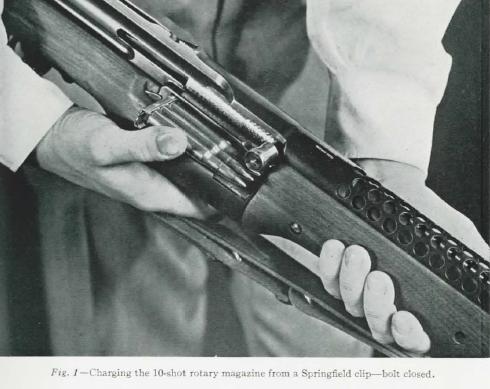Everyone recognizes the M1 Garand as the iconic US rifle of World War II, but it had many competitors (you can see some of them in the M1 Garand Development section of the Vault). Most of these had fallen to the wayside by 1940, but Melvin Johnson’s had not. He designed a recoil operated rifle to meet military specifications, and pushed hard for its adoption. It was tested for several years by the US Army, and ultimately rejected in favor of the Garand.
However, it had one particular feature that made it attractive to the Marine Corps paratroopers – the barrel could be easily removed and replaced, using just a cartridge. This made it into a much shorter package than the Garand, and thus better suited to strapping to one’s leg for a jump. The Dutch government had ordered a large number of the rifles at the same time, but its colonies in the Pacific were being overrun by the Japanese before it could put the rifles to use. So the USMC appropriated a number of the rifles (by then designated the M1941), and they saw action with several Marine units.
The Johnson design has several interesting features. It was offered with either detachable box magazines (few of which were made) or a 10-round rotary magazine (which accounts for the Dutch/USMC production). The magazine could be loaded either singly or with standard 5-round clips, with the bolt either open or closed.
 It also used a rotating, multi-lug bolt which would go on to inspire a very similar design for the AR series of rifles. In addition, some of the members of the Johnson development team were very sympathetic to the Jewish cause in the late 1940s, and arranged for the technical package on the Johnson to be given to the Israeli armed forces, where it became the Dror light machine gun (which we will cover here sooner or later).
It also used a rotating, multi-lug bolt which would go on to inspire a very similar design for the AR series of rifles. In addition, some of the members of the Johnson development team were very sympathetic to the Jewish cause in the late 1940s, and arranged for the technical package on the Johnson to be given to the Israeli armed forces, where it became the Dror light machine gun (which we will cover here sooner or later).
But back to 1940 – we have a complete copy of Johnson’s early military handbook on the rifle. It was published before USMC acceptance of the rifle, and spends several pages describing how the Johnson meets all military requirements. You can find it on the Original Manuals page of the Vault, or download it directly here:

Very interesting !!! Especially the bolt carrier group – it’s so similar to Ar15 one!!!
There is a very good reason for your observation of the bolt carrier group similarity. Melvin Johnson was hired by Colt and ArmaLite as a consultant, since they were using his design patents for the bolt carier group in the AR-10 and AR-15.
Thanks so much for posting the manual! I recently got a Winfield sporter from another collector who was rebuilding it into military configuration with original parts, but there wasn’t a manual. This really helps!
Odd that he used a single column magazine for his LMG version.
The rifle version, I am told, had reliability problems if you tried to fire it with the bayonet fixed. That could have been resolved with a permanently attached folding bayonet, but wasn’t. Not that bayonets were often decisive (I, personally, would choose to use a pistol if noise was not an issue, or a knife if noise was an issue, rather than a bayonet.)